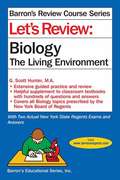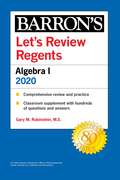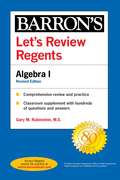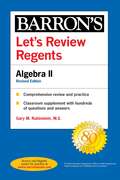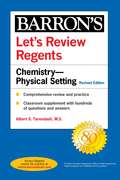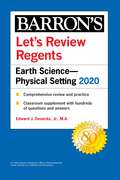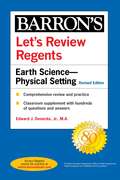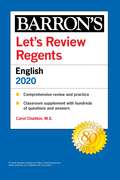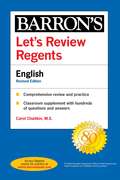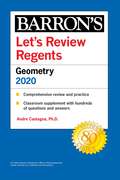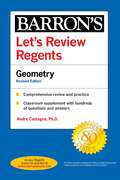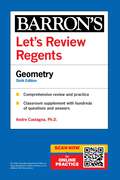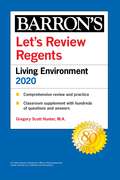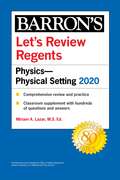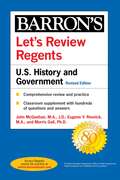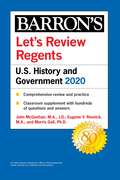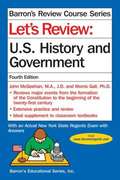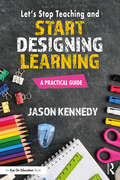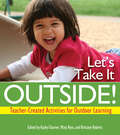- Table View
- List View
Let's Review Biology: The Living Environment (Sixth Edition )
by Gregory Scott HunterThis updated biology review book covers all topics prescribed by the New York State Board of Regents and serves as a valuable companion to high school biology textbooks.
Let's Review Regents: Algebra I 2020 (Barron's Regents NY)
by Gary M. RubinsteinBarron's Let's Review Regents: Algebra I 2020 gives students the step-by-step review and practice they need to prepare for the Regents exam. This updated edition is an ideal companion to high school textbooks and covers all Algebra I topics prescribed by the New York State Board of Regents. Features include: * In-depth Regents exam preparation, including two recent Algebra I Regents exams and answer keys * Easy to read topic summaries * Step-by-step demonstrations and examples * Review of all Algebra I topics * Hundreds of sample questions with fully explained answers for practice and review, and more Teachers can also use this book to plan lessons and as a helpful resource for practice, homework, and test questions. Looking for additional review? Check out Barron’s Regents Algebra I Power Pack 2020 two-volume set, which includes Regents Exams and Answers: Algebra I 2020 in addition to Let’s Review Regents: Algebra I 2020.
Let's Review Regents: Algebra I Revised Edition (Barron's Regents NY)
by Gary M. RubinsteinBarron's Let's Review Regents: Algebra I 2020 gives students the step-by-step review and practice they need to prepare for the Regents exam. This updated edition is an ideal companion to high school textbooks and covers all Algebra I topics prescribed by the New York State Board of Regents. All Regents test dates for 2020 have been canceled. Currently the State Education Department of New York has released tentative test dates for the 2021 Regents. The dates are set for January 26-29, 2021, June 15-25, 2021, and August 12-13th. Features include:In-depth Regents exam preparation, including two recent Algebra I Regents exams and answer keysEasy to read topic summariesStep-by-step demonstrations and examplesReview of all Algebra I topicsHundreds of sample questions with fully explained answers for practice and review, and moreTeachers can also use this book to plan lessons and as a helpful resource for practice, homework, and test questions.Looking for additional review? Check out Barron&’s Regents Algebra I Power Pack 2020 two-volume set, which includes Regents Exams and Answers: Algebra I 2020 in addition to Let&’s Review Regents: Algebra I 2020.
Let's Review Regents: Algebra II Revised Edition (Barron's Regents NY)
by Gary M. Rubenstein M.S.Barron's Let's Review Regents: Algebra II 2020 gives students the step-by-step review and practice they need to prepare for the Regents exam. This updated edition is an ideal companion to high school textbooks and covers all Algebra II topics prescribed by the New York State Board of Regents. All Regents test dates for 2020 have been canceled. Currently the State Education Department of New York has released tentative test dates for the 2021 Regents. The dates are set for January 26-29, 2021, June 15-25, 2021, and August 12-13th. Features include:In-depth Regents exam preparation, including two recent Algebra II Regents exams and answer keysEasy to read topic summariesStep-by-step demonstrations and examplesHundreds of sample questions with fully explained answers for practice and review, and moreReview of all Algebra II topics, including Polynomial Functions, Exponents and Equations, Transformation of Functions, Trigonometric Functions and their Graphs, Using Sine and Cosine, and much moreTeachers can also use this book to plan lessons and as a helpful resource for practice, homework, and test questions.Looking for additional practice and review? Check out Barron&’s Algebra II Power Pack 2020 two-volume set, which includes Regents Exams and Answers: Algebra II 2020 in addition to Let&’s Review Regents: Algebra II 2020.
Let's Review Regents: Chemistry--Physical Setting 2020 (Barron's Regents NY)
by Albert S. TarendashBarron's Let's Review Regents: Chemistry 2020 gives students the step-by-step review and practice they need to prepare for the Regents Chemistry/Physical Setting exam. This updated edition is an ideal companion to high school textbooks and covers all Chemistry topics prescribed by the New York State Board of Regents. Let's Review Regents: Chemistry 2020 covers all high school-level Chemistry topics and includes: * Extensive review of all topics on the test * Extra practice questions with answers * A detailed introduction to the Regents Chemistry course and exam * One actual, recently released, Regents Chemistry exam with an answer key Looking for additional practice and review? Check out Barron’s Regents Chemistry Power Pack 2020 two-volume set, which includes Regents Exams and Answers: Chemistry 2020 in addition to Let’s Review Regents: Chemistry 2020.
Let's Review Regents: Chemistry--Physical Setting Revised Edition (Barron's Regents NY)
by Albert S. Tarendash M.S.Barron's Let's Review Regents: Chemistry gives students the step-by-step review and practice they need to prepare for the Regents Chemistry/Physical Setting exam. This updated edition is an ideal companion to high school textbooks and covers all Chemistry topics prescribed by the New York State Board of Regents. All Regents test dates for 2020 have been canceled. Currently the State Education Department of New York has released tentative test dates for the 2021 Regents. The dates are set for January 26-29, 2021, June 15-25, 2021, and August 12-13th. Let's Review Regents: Chemistry covers all high school-level Chemistry topics and includes:Extensive review of all topics on the testExtra practice questions with answersA detailed introduction to the Regents Chemistry course and examOne actual, recently released, Regents Chemistry exam with an answer keyLooking for additional practice and review? Check out Barron&’s Regents Chemistry Power Pack two-volume set, which includes Regents Exams and Answers: Chemistry in addition to Let&’s Review Regents: Chemistry.
Let's Review Regents: Earth Science--Physical Setting 2020 (Barron's Regents)
by Edward J. Denecke Jr.Barron's Let's Review Regents: Earth Science 2020 gives students the step-by-step review and practice they need to prepare for the Regents exam. This updated edition is an ideal companion to high school textbooks and covers all Physical Setting/Earth Science topics prescribed by the New York State Board of Regents. This useful supplement to high school Earth Science textbooks features:Comprehensive topic review covering fundamentals such as astronomy, geology, and meteorology. The 2011 Edition Reference Tables for Physical Setting/Earth ScienceMore than 1,100 practice questions with answers covering all exam topics drawn from recent Regents examsOne recent full-length Regents exam with answersLooking for additional practice and review? Check out Barron’s Regents Earth Science Power Pack 2020 two-volume set, which includes Regents Exams and Answers: Earth Science 2020 in addition to Let’s Review Regents: Earth Science 2020.
Let's Review Regents: Earth Science--Physical Setting Revised Edition (Barron's Regents NY)
by Edward J. Denecke Jr.Barron's Let's Review Regents: Earth Science 2020 gives students the step-by-step review and practice they need to prepare for the Regents exam. This updated edition is an ideal companion to high school textbooks and covers all Physical Setting/Earth Science topics prescribed by the New York State Board of Regents. All Regents test dates for 2020 have been canceled. Currently the State Education Department of New York has released tentative test dates for the 2021 Regents. The dates are set for January 26-29, 2021, June 15-25, 2021, and August 12-13th. This useful supplement to high school Earth Science textbooks features:Comprehensive topic review covering fundamentals such as astronomy, geology, and meteorologyThe 2011 Edition Reference Tables for Physical Setting/Earth ScienceMore than 1,100 practice questions with answers covering all exam topics drawn from recent Regents examsOne recent full-length Regents exam with answersLooking for additional practice and review? Check out Barron&’s Regents Earth Science Power Pack 2020 two-volume set, which includes Regents Exams and Answers: Earth Science 2020 in addition to Let&’s Review Regents: Earth Science 2020.
Let's Review Regents: English 2020 (Barron's Regents)
by Carol ChaitkinBarron's Let's Review Regents: English 2020 gives students the step-by-step review and practice they need to prepare for the Regents exam. This updated edition is an ideal companion to high school textbooks and covers all English topics prescribed by the New York State Board of Regents. This edition features:One actual full-length New York State Regents examInstructions on reading prose fiction, prose nonfiction, and poetry for understandingReview of the fundamentals of essay writing and advises on writing for the Regents examReview of grammar, vocabulary, and spellingLooking for additional review? Check out Barron&’s Regents English Power Pack 2020 two-volume set, which includes Let&’s Review Regents: English 2020 in addition to the Regents Exams and Answers: English 2020 book.
Let's Review Regents: English Revised Edition (Barron's Regents NY)
by Carol ChaitkinBarron's Let's Review Regents: English gives students the step-by-step review and practice they need to prepare for the Regents exam. This updated edition is an ideal companion to high school textbooks and covers all English topics prescribed by the New York State Board of Regents. All Regents test dates for 2020 have been canceled. Currently the State Education Department of New York has released tentative test dates for the 2021 Regents. The dates are set for January 26-29, 2021, June 15-25, 2021, and August 12-13th. This edition features:One actual full-length New York State Regents examInstructions on reading prose fiction, prose nonfiction, and poetry for understandingReview of the fundamentals of essay writing and advises on writing for the Regents examReview of grammar, vocabulary, and spellingLooking for additional review? Check out Barron&’s Regents English Power Pack two-volume set, which includes Let&’s Review Regents: English in addition to the Regents Exams and Answers: English book.
Let's Review Regents: Geometry 2020 (Barron's Regents)
by Andre CastagnaBarron's Let's Review Regents: Geometry 2020 gives students the step-by-step review and practice they need to prepare for the Regents exam. This updated edition is an ideal companion to high school textbooks and covers all Geometry topics prescribed by the New York State Board of Regents.This edition includes: Two actual Regents exams in Geometry, plus answer keys for each test. Review and practice problems for all topics on the exam, including the language of geometry, basic geometric relationships (parallel lines, polygons, and triangle relationships), constructions, an introduction to geometric proof transformations, triangle congruence, similarity and right triangle trigonometry, parallelograms, circles and arcs, coordinate geometry and proofs on the coordinate plane, and volume (modeling 3-D shapes in practice applications) Looking for additional review? Check out Barron’s Regents Geometry Power Pack 2020 two-volume set, which includes Regents Exams and Answers: Geometry 2020 in addition to Let’s Review Regents: Geometry 2020.
Let's Review Regents: Geometry Revised Edition (Barron's Regents NY)
by Andre Castagna Ph.D.Barron's Let's Review Regents: Geometry 2020 gives students the step-by-step review and practice they need to prepare for the Regents exam. This updated edition is an ideal companion to high school textbooks and covers all Geometry topics prescribed by the New York State Board of Regents.All Regents test dates for 2020 have been canceled. Currently the State Education Department of New York has released tentative test dates for the 2021 Regents. The dates are set for January 26-29, 2021, June 15-25, 2021, and August 12-13th. This edition includes:Two actual Regents exams in Geometry, plus answer keys for each testReview and practice problems for all topics on the exam, including the language of geometry, basic geometric relationships (parallel lines, polygons, and triangle relationships), constructions, an introduction to geometric proof transformations, triangle congruence, similarity and right triangle trigonometry, parallelograms, circles and arcs, coordinate geometry and proofs on the coordinate plane, and volume (modeling 3-D shapes in practice applications)Looking for additional review? Check out Barron&’s Regents Geometry Power Pack 2020 two-volume set, which includes Regents Exams and Answers: Geometry 2020 in addition to Let&’s Review Regents: Geometry 2020.
Let's Review Regents: Geometry, Sixth Edition (Barron's New York Regents)
by Barron's Educational Series Andre, Ph.D. Castagna Ph.D.Barron's Let's Review Regents: Geometry gives students the step-by-step review and practice they need to prepare for the Regents exam. This updated edition is an ideal companion to high school textbooks and covers all Geometry topics prescribed by the New York State Board of Regents. Features include: In-depth Regents exam preparation, including one recent Geometry Regents exam and a sample of the revised test for the changes being made for 2025, both with full answer keys Review of all Geometry topics as per the revised course and exam for 2025 Easy to read topic summaries Revised step-by-step demonstrations and examples Hundreds of questions with fully explained answers for extra practice and review, and more Publisher's Note: Products purchased from 3rd party sellers are not guaranteed by the publisher for quality, authenticity, or access to any online entities included with the product.
Let's Review Regents: Global History and Geography 2020 (Barron's Regents NY)
by David Moore Jerry Weiner George Hero Mary Martin Mark Willner M.S.Written by experienced, award-winning teachers of Global History from throughout New York State, Let's Review Regents: Global History and Geography 2020 has been fully updated to review the &“Transition Exam&” format, cover significant world events from 1750 to the present, and include practice questions as well as two actual, recently released, Global History and Geography &“Transition Exams&” with answer keys and online access to an overview of the &“Global History and Geography II Exam.&”This book offers:Extensive review of all frequently tested topics from 1750 to the presentExtra practice questions with answers for all tested topicsA detailed overview of the &“Transition Exam&” and an introduction to the courseA thorough glossary of all key terms from 1750 to the presentTwo actual, recently released, Global History and Geography &“Transition Exams&” with answer keysA webpage that contains an overview of the &“Global History and Geography II Exam&” and answers to frequently asked questions about that version of the examThis book is designed primarily to prepare high school students for the Global History and Geography Regents exams, but it will also be helpful to students in their daily Global History and Geography coursework.Looking for additional practice and review? Check out Barron&’s Regents Global History and Geography Power Pack 2020 two-volume set, which includes Regents Exams and Answers: Global History and Geography in addition to Let&’s Review Regents: Global History and Geography.
Let's Review Regents: Living Environment 2020 (Barron's Regents)
by Gregory Scott HunterBarron's Let's Review Regents: Living Environment 2020 gives students the step-by-step review and practice they need to prepare for the Regents exam. This updated edition is an ideal companion to high school textbooks and covers all Biology topics prescribed by the New York State Board of Regents. You’ll get two recent Regents exams and question sets with explanations of answers and wrong choices. The edition also features teachers’ guidelines for developing New York State standards-based learning units. Two comprehensive study units cover the following material: Unit One explains the process of scientific inquiry, including the understanding of natural phenomena and laboratory testing in biology. Unit Two focuses on specific biological concepts, including cell function and structure, the chemistry of living organisms, genetic continuity, the interdependence of living things, the human impact on ecosystems, and several other pertinent topicsLooking for additional review? Check out Barron’s Regents Living Environment Power Pack 2020 two-volume set, which includes Regents Exams and Answers: Living Environment 2020 in addition to Let's Review Regents: Living Environment 2020.
Let's Review Regents: Living Environment Revised Edition (Barron's Regents NY)
by Gregory Scott HunterBarron's Let's Review Regents: Living Environment gives students the step-by-step review and practice they need to prepare for the Regents exam. This updated edition is an ideal companion to high school textbooks and covers all Biology topics prescribed by the New York State Board of Regents. All Regents test dates for 2020 have been canceled. Currently the State Education Department of New York has released tentative test dates for the 2021 Regents. The dates are set for January 26-29, 2021, June 15-25, 2021, and August 12-13th. You&’ll get one recent Regents exam and question set with explanations of answers and wrong choices. The edition also features teachers&’ guidelines for developing New York State standards-based learning units. Two comprehensive study units cover the following material:Unit One explains the process of scientific inquiry, including the understanding of natural phenomena and laboratory testing in biologyUnit Two focuses on specific biological concepts, including cell function and structure, the chemistry of living organisms, genetic continuity, the interdependence of living things, the human impact on ecosystems, and several other pertinent topicsLooking for additional review? Check out Barron&’s Regents Living Environment Power Pack two-volume set, which includes Regents Exams and Answers: Living Environment in addition to Let's Review Regents: Living Environment.
Let's Review Regents: Physics--Physical Setting 2020 (Barron's Regents)
by Albert Tarendash Miriam A. LazarBarron's Let's Review Regents: Physics 2020 gives students the step-by-step review and practice they need to prepare for the Regents exam. This updated edition is an ideal companion to high school textbooks and covers all Physics topics prescribed by the New York State Board of Regents. This edition include one recently-administered actual Physics Regents Exam and provides in-depth review of all topics on the test, including: Motion in one dimensionForces and Newton’s laws, Vector quantities and their applications, Circular motion and gravitation, Momentum and its conservation, Work and energy, Properties of matter, Static electricity, electric current and circuits, Magnetism and electromagnetism, Waves and soundLight and geometric optics, Solid-state physics, Modern physics from Planck’s hypothesis to Einstein’s special theory of relativity, Nuclear energy. Looking for additional review? Check out Barron’s Physics Power Pack 2020 two-volume set, which includes Regents Exams and Answers: Physics 2020 in addition to Let’s Review Regents: Physics 2020.
Let's Review Regents: Physics--The Physical Setting Revised Edition (Barron's Regents NY)
by Albert Tarendash M.S. Miriam A. Lazar M.S.Barron's Let's Review Regents: Physics 2020 gives students the step-by-step review and practice they need to prepare for the Regents exam. This updated edition is an ideal companion to high school textbooks and covers all Physics topics prescribed by the New York State Board of Regents. All Regents test dates for 2020 have been canceled. Currently the State Education Department of New York has released tentative test dates for the 2021 Regents. The dates are set for January 26-29, 2021, June 15-25, 2021, and August 12-13th. This edition include one recently-administered actual Physics Regents Exam and provides in-depth review of all topics on the test, including:Motion in one dimensionForces and Newton&’s lawsVector quantities and their applicationsCircular motion and gravitationMomentum and its conservationWork and energyProperties of matterStatic electricity, electric current and circuitsMagnetism and electromagnetismWaves and soundLight and geometric opticsSolid-state physicsModern physics from Planck&’s hypothesis to Einstein&’s special theory of relativityNuclear energyLooking for additional review? Check out Barron&’s Physics Power Pack 2020 two-volume set, which includes Regents Exams and Answers: Physics 2020 in addition to Let&’s Review Regents: Physics 2020.
Let's Review Regents: U.S. History and Government 2020 (Barron's Regents)
by Morris Gall Eugene V. Resnick M.A. John McGeehan M.A. J.D.Barron's Let's Review Regents: U.S. History and Government 2020 gives students the step-by-step review and practice they need to prepare for the Regents exam. This updated edition is an ideal companion to high school textbooks and covers all U.S. History and Government topics prescribed by the New York State Board of Regents. You’ll get an overview of American history in its totality, starting with the Colonial era and concluding with recent significant events. This edition includes: The latest New York State Regents U.S. History and Government Exam, Summaries of key topics with maps, charts, and illustrations, Review exercises consisting of questions with answers, A detailed chronology of major events in American history, Thumbnail biographies of notable Americans, A glossary of history terms and an extensive index. Looking for additional practice and review? Check out Barron&’s Regents U.S. History and Government Power Pack 2020 two-volume set, which includes Regents Exams and Answers: U.S. History and Government 2020 in addition to Let’s Review U.S. History and Government.
Let's Review Regents: U.S. History and Government Revised Edition (Barron's Regents NY)
by Eugene V. Resnick M.A. John McGeehan M.A. J.D. Morris Gall Ph.D.Barron's Let's Review Regents: U.S. History and Government gives students the step-by-step review and practice they need to prepare for the Regents exam. This updated edition is an ideal companion to high school textbooks and covers all U.S. History and Government topics prescribed by the New York State Board of Regents. You&’ll get an overview of American history in its totality, starting with the Colonial era and concluding with recent significant events. All Regents test dates for 2020 have been canceled. Currently the State Education Department of New York has released tentative test dates for the 2021 Regents. The dates are set for January 26-29, 2021, June 15-25, 2021, and August 12-13th. This edition includes:The latest New York State Regents U.S. History and Government ExamSummaries of key topics with maps, charts, and illustrationsReview exercises consisting of questions with answersA detailed chronology of major events in American historyThumbnail biographies of notable AmericansA glossary of history terms and an extensive indexLooking for additional practice and review? Check out Barron&’s Regents U.S. History and Government Power Pack two-volume set, which includes Regents Exams and Answers: U.S. History and Government in addition to Let&’s Review U.S. History and Government.
Let's Review: U. S. History and Government (4th edition)
by John Mcgeehan Morris GallThis supplementary classroom text reviews American history in its totality, starting with the Colonial era and concluding with events of the twenty-first century. The book presents summaries of hundreds of key topics, maps, charts, illustrations, review exercises, a 13-page chronology of major events in American history, thumbnail biographies of notable Americans, a glossary of terms, and an extensive index. Shaded page edges give students quick access to any one of six general study units: Constitutional Foundations, Industrialization, The Progressive Movement, Prosperity and Depression (1917-1940), The United States in an Age of Global Crisis, and A World in Uncertain times (1950-Present). Also presented is the latest New York State Regents Exam with answers. Designed primarily for use in New York State high schools, this book can be used virtually everywhere because it covers topics as they are taught in secondary schools throughout the country.
Let's Shake on It!
by Roger C. Farr Dorothy S. StricklandThis book will let you meet many new characters and will take you to new places. You'll read about two friends that dream the same dream. You'll see that a bear and a mouse can find something they both like. You'll see that people can be different but also alike.
Let's Stop Teaching and Start Designing Learning: A Practical Guide
by Jason KennedyHow can you shift from a focus on content to the creation of active learning experiences? In this practical resource, author Jason Kennedy provides a blueprint to help you stop "teaching" and start designing learning, so you can improve students’ critical thinking, decision making, problem solving, and collaboration with others, preparing them for their futures beyond school doors. The framework for learning design covers components of planning (learning targets), of instruction (the opening, learning task, skills, tools, and success criteria), and of the work session (choices, pathways, feedback, and assessment). Appropriate for teachers of any subject area, the book also offers wide variety of tools to help you implement the ideas in your own setting.
Let's Take It Outside!: Teacher-Created Activities for Outdoor Learning
by Kathy Charner Mary Rein Brittany RobertsChildren love outdoor play. Now teachers can combine the magic and excitement of the outdoors with activities that encourage and support learning! With more than 100 new teacher-created, classroom-tested outdoor activities, Let's Take It Outside! engages children's minds and bodies as they explore the limitless bounds of the outdoors while also building key skills in areas like math, literacy and language, science, art, and music. Perfect for ages 3 to 6, the activities in Let's Take It Outside! take kids on an outdoor adventure as they make mud-dough letters, go on a rainbow scavenger hunt, and play animal charades. Let's Take It Outside! is the result of a nationwide contest among teachers. The best of the best activities are selected and organized by theme for easy use. * Counting * Alphabet * Colors * Shapes * Art * Touch * Sound and sight * Plants and gardening * Bubbles and air * Light and shadow * Animals and insects * Dramatic play * Large motor skills
Let's Talk about Flex: Flipping the flexible working narrative for education
by Emma TurnerThe narrative around flexible working needs flipping. After being able to work flexibly for 14 of her 23 years in education across teaching, school leadership and MAT leadership roles, Emma Turner realised that sadly, she's actually in the minority and has just been kinda lucky. Across the education system, although there is a recent groundswell of support for developing more life friendly, innovative and flexi ways of working, there are still a great deal of misconceptions, biases and prejudices about flexible working and flexible workers. Through her 'playlist' of educational floor fillers, Emma explores some of the successful ways in which flexible working can be viewed by both employers and employees for staff at all levels, including senior and school leadership. Designed to open up the flexible working conversation, this book outlines what can work, what has worked and what could work. This new way of viewing the flexi narrative from an experienced flex-pert encourages all to revisit our views on flexible working.
